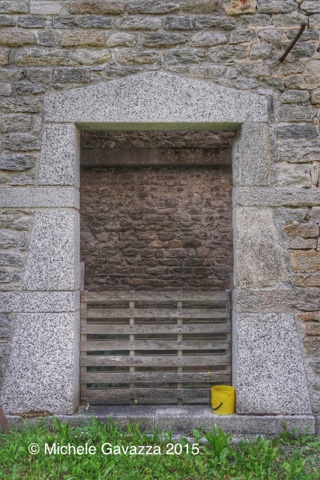mercoledì 29 luglio 2015
The chestnut of Maglioggio
The chestnut called "Bona Maria" is located just outside the town of Maglioggio (fraction of Crodo). The chestnut tree 25 meters high, with a circumference of 8.5 meters has an estimated age of 350-400 years. Since 2004, the plant is included in the list of monumental trees of the Piedmont Region.
Etichette:
400 years old tree,
Chestnut,
Italy,
Maglioggio,
ossola
lunedì 27 luglio 2015
The revenge of nature - Ossola
The revenge of nature: the remains of houses in the forest, remains of old buildings, perhaps the nineteenth century, along the path leading from Emo to Mozzio (two hamlets near Crodo). Relatively speaking, a small yet Angkor Wat in Val d'Ossola.
sabato 25 luglio 2015
Forest an woods of Ossola
the mixed deciduous forest starts from the valley floor, the prevailing species are: the chestnut and oak trees, past the 900 m above sea level, give way to beech and spruce first, and then larches.
venerdì 24 luglio 2015
Haymaking in Ossola
1. The mowing
Mowing (in sigàa) normally begins early in the morning (at 4 to the first cutting of hay), to take advantage of the cooler hours of the day. The cut grass is collected in a long strip or swath called ònsgia. At about 8.00 becomes a stop for breakfast: the mowers (sigadür) women wear, in a basket, brown bread, cheese, salami and a gourd full of wine.
The grass is then subjected to drying, spreading it on the ground, generally with the help of a trident or a rake (slargàa the ònsg; elsewhere: spantigàa). This is typically done by women.
If the weather is too wet, the hay does not lose all its moisture (FEN basgiòk) and is likely to grow mold or rot. If instead the air is too dry hay, due to the rapid drying, it crumbles (to makes the crüau). To get a good hay is therefore necessary to wait as long as favorable as possible.
3. The turning
To allow the hay to dry thoroughly, you must turn it with the rake (vutàa to FEN). This operation is carried out in the early afternoon
4. Stacking
The evening of the first day the hay is collected in piles (in mügiàa 's Fen; to caplinàa tarzüal u) to protect it from moisture night. The same is necessary when lightning storms. The piles of hay first cutting usually are larger.
5. spreader and turning on the second day
The morning of the second day the hay is spread again (to slargàa MUCC) and allowed to dry until the afternoon.
collection
When the hay, after shedding and possible turning, is quite dry, it collects with the rake in long windrows (FAA the ònsc). At this point it is ready to be transported to the barn (the Cassina from fen). In the mountains for this purpose using the basket upside sparse (scivirùn), while the valley floor once used the wagon with two or four wheels (the dear from fen) pulled by a donkey. Who did not have a donkey instead used a two-wheeled cart pulled by hand.
The conservation
The hay crop is then transported in the barn (Cassina from Fen), which usually is located in the area above the stable (Cassina of cows). There is suitably massed and allowed to ferment (in ciapàa to boi). In winter, then, it will be sent down directly in the barn (to siaa sgiü) through a trap door (fnèr elsewhere Fener, from Latin FOENARIUM).
In ancient times they were also of haystacks outdoors conical.
Etichette:
haymaking,
Italy,
mowing,
ossola,
shedding of hay
Ubicazione:
28862 Crodo VB, Italia
venerdì 17 luglio 2015
Climbing in Val d'Ossola - the climbing "Balma Fregia"
the climbing "Balma Fregia" is one of the most beautiful of Ossola, equipped with multiple levels of difficulty. Ideal for families and very popular. Access is free.
giovedì 16 luglio 2015
Lime-kiln (about 1700)
The lime-kiln of Piedilago (Premia) The artisanal production of lime was done "cooking" at high temperatures fragments of limestone.
Furnace has a drywall circular thickness of 2.2 meters. The ordered accumulation in the interior of the limestone blocks allow to obtain a chamber below which constituted the feeding area of the fire.
The room calcining an inside height of 3.8 meters and an average diameter of 3 meters and could be loaded with about 20 cubic meters of limestone. The rock fragments came from the steep cliffs above Piedilago and were transported to the furnace with a cableway.
giovedì 9 luglio 2015
Medieval tower of Premia
Medieval tower (second half of the fifteenth century) in the municipality of Premia località Cristo, tenere is a medieval tower, the tower is built of local stone and was 4 floors and It has a massive amount, with 6.9 square meters on each side and 90 cm thick walls. The fortification was necessary to report the danger approaching enemies from Switzerland. It was commissioned and built by the Duke of Milan, along with many other structures that had the same aim of defense and control of the territory.
Iscriviti a:
Commenti (Atom)

















































